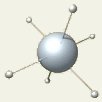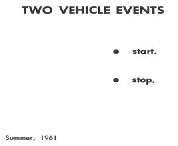
 |
Algorithmic Art -- Composing the Score for Visual Art by Roman Verostko |
 Algorithmic design detail, Hispano-Moorish tile (azulejos), 14th Century, Nasrid Palaces, Granada, Spain. Photo: RV |
Algorithm (variant: algorism).For term origins, spelling and example see [1] What
is an algorithm? An algorithm may be viewed simply as a detailed recipe
for carrying out a task. The term has its origin in mathematics as the
step-by-step procedure for solving a problem. The commonplace procedures
we use for multiplying and dividing numbers are algorithms. With precise
details for each step, the procedures yield the same result whether executed
by a computer or by a human, which is why robots are able to handle many
tasks that were once done only by humans.
Many view an 'algorithmic procedure' as a strictly mathematical operation. Today we are inclined to understand any well-defined procedure as an algorithm. A recipe for baking bread is an algorithm. Follow the recipe faithfully and you will duplicate the kind of bread made by the person who wrote the recipe. Applications. Machines can also be made to follow recipes. The programmed circuitry in our bread-making machine directs the machine's mechanism on precisely how to mix ingredients, knead the dough, and bake the bread. It succeeds every time! Within the past quarter of a century, operational instructions have been imbedded in the design of many industrial and household utilities. They implement our daily use of telephones, automobiles, cameras, TVs, and radios. Our hospitals, factories, banks, and shopping centers all depend on the algorithms that control inventories, transactions, communications and security. They are ubiquitous and our mass culture would collapse without them. Algorithmic procedures are also imbedded in the digital tools used in the arts. Use of these tools influences form in the practice of film, architecture, photography, music, printmaking, and all types of electronic sound and image. The drudgery of executing algorithms, which would require immense time, or would even be impossible to execute without computing power, has been handed over to the machine -- leaving humans more freedom to focus on the creative part of their work. For the artist, this means improving and improvising the art-making procedure. For the algorist, work on the algorithm is work on the procedure. History & breadth. Although the term derives from the name of a 9th century mathematician, the use of algorithms dates from prehistoric times. Study of the stone circles at Stonehenge (c. 2000 BC) reveals an algorithmic arrangement based on phases of the moon and the annual movement of the sun. While we cannot know the meanings that the builders attached to the structure, we are able to discern something of the 'rules' for stone positions. Their alignment relates to the annual movement of the sun and the moon. |
Stonehenge, c. 2000 BC, ff. Algorithmic arrangement, Salisbury plain, England. Ca. 24 ft high. Photo: RV |
Clearly,
early civilizations developed procedures for counting and measuring. They
also created procedures for weaving, grinding, making fire and cooking.
Any of these procedures, when well defined, could be viewed as an algorithm.
Indeed, weaving technology played an important role in the history of
computers. If we can spell out the procedure for any given task then,
given all the necessary materials and skills, we should be able to carry
out the task.
Architectural plans, musical scores and dance notations [2] bear one feature in common -- they are all recipes for carrying out a task. From this perspective, a broad range of notational systems can be viewed and studied as algorithmic procedure. Algorithmic procedures for generating artistic forms enjoy a rich and varied tradition, even though we have used other terms to describe them. Algorithms
and art
Gregorian
Chant, Missal, c.1200. Detail from the Sursum Corda.
Musical
scores, viewed as instructions, are algorithms for performing music.
In
Art History. A history of algorithms in the visual arts would be voluminous
touching many phases in every culture at every turn -- the Egyptian
canons for drawing the human figure, the infinite geometric play in
Islamic art and the role of both linear perspective and proportion in
Renaissance art. In China, we would find the Mustard Seed Manual and,
in Byzantium, the conventions for icon painting. In Europe, we would
find extremely sophisticated algorithms for plotting the dizzying perspectives
imaging the passage from earth to heaven by the 17th century.
Even so, notational systems for the visual arts played a limited role when compared to notational systems for music. A gifted composer could compose a score for a profoundly moving musical passage that could be played hundreds of years later by a skilled virtuoso. Not so for the painter. While Leonardo could easily compose an algorithm for creating the perspective space in the Last Supper, he could not, at that time, compose an algorithm for rendering the face of Judas. The
20th Century. A 20th century history would find some interesting pre-algorist
examples in the 1960s and 1970s. Fluxus, minimalist, and conceptual
artists employed various methods of procedural specification challenging
traditional conceptions of art. For example, George Brecht's early works
were primarily very lean instructions printed on cards; the instruction
became art. But it was not until artists gained access to computing
power that they were able to compose form-generators for the investigation
of form.
 George Brecht, 1961, Two Vehicle Events, Detail of a 3.5 " by 4.5 " white card with printed text. George Brecht sent this card, along with others, to RV in 1961. This is one of many examples from the 1960s where artists employed detailed instruction for constructing an experience. In one such work, "Vehicle Sundown Event," GB published 50 cards reproduced in sets for each participant. Each card held an instruction to be performed with a vehicle. Vehicles with drivers were instructed to assemble at sundown in a parking lot and randomly park their vehicles. Then each driver, with a shuffled deck of instructions, performed 50 events such as "turn on lights," "start engine," "stop engine," "open window." This work was performed at St Vincent College under the direction of Stephen Joy in 1963. The
Algorists. As computers became more accessible to artists in the 1970s
and 1980s, some artists began to experiment with algorithmic procedure.
The new technology offered them methods of working algorithmically
that were unavailable before the advent of computers. By the 1980s,
a number of these artists were working with the pen plotter, a machine
with a 'drawing arm.' By the end of the 1980s, algorists like Harold
Cohen, Mark Wilson, Manfred Mohr, Jean Pierre Hebert and myself had
already achieved a mature body of work. Each in their own way had
invented algorithmic procedures for generating their art and created
their own distinctive style. Clearly, style and algorithm were linked
in a very important way. [8]
Simply put, algorists are artists who introduce and control original algorithms in the creation of their work. Jean Pierre Hebert, a master algorist himself, has written an algorithm that identifies an algorist as one who uses one's own algorithms for creating art objects. Hebert's algorithm, lean and beautiful in itself, identifies the essential features of algorist art. As the JPH algorithm makes clear, an algorist, in the proper sense of the word, employs her own algorithms in the process. Even so, all artists, including algorists build with and upon the algorithms, namely the procedures, set forth by our predecessors and colleagues. Like all survivors, we algorists stand on the shoulders of those who preceded us. The Algorists, historical notes  Peter
Beyls, 1988, Ghent, Belgium
Untitled
algorithmic pen plotter drawing tinted with watercolor.
11.5"
by 16.5". Artist's software
Hardware:
Symbolics 3600 & HP plotter
The
following are brief notes on the origin of the algorists with pointers
to related theory and practice. Jean Pierre Hebert maintains several
algorist pages on his web site at http://hebert.kitp.ucsb.edu/studio/algorists.html.
Who are the algorists? Simply put, algorists are artists who create art using algorithmic procedures that include their own algorithms. A key issue in discussions on algorithmic art centers on the relationship between art forms and the procedures employed in achieving those forms. With the advent of computers this relationship became crucial.  Jean
Pierre Hebert, 1999. Santa Barbara, CA.
Artist's
coded procedure from 100 views of a metagon (http://hebert.kitp.ucsb.edu/hv/hv.html)
Giclee
print 8" by 8" image on paper, Somerset Book, measuring
12.75" by 19".
In
the last twenty five years of the 20th century, various symposia
and conferences began to include exhibitions and papers related
to the use of computing procedures in the arts. [8] By the late
1980s, a number of artists using original algorithms had achieved
distinctive styles, each with a body of mature work. Working independently
of each other, several found that they shared similar experiences
over the years. Following the 1995 panel on "Artists and Algorithms"
in Los Angeles, Jean Pierre Hebert, Ken Musgrave and I briefly discussed
forming an informal group of artists who shared similar interests
in algorithmic procedure. [9]
For several months, we corresponded in search of a term with possible ways to share views. Eventually we settled on the term "algorist" as defined by Jean Pierre. He wrote an algorithm that identifies an algorist as one who uses one's own algorithms for creating art objects. The classic Hebert algorithm, as quoted here, dates from correspondence in September 1995: if
(creation && object of art && algorithm &&
one's own algorithm) {
include
* an algorist *
}
elseif (!creation || !object of art || !algorithm || !one's own
algorithm) {
exclude
* not an algorist *
}
This definition identifies an algorist as one who creates an object of art employing algorithms that include one's own algorithm. In the course of our work, with or without computers, we all employ algorithms created by our predecessors and colleagues. The use of algorithms in and of itself does not constitute algorist work. As defined in the Hebert algorithm, it is the inclusion of one's own algorithms that makes the difference. Finally,
one aspect of the algorist definition remains open to interpretation.
An algorist, by definition, creates an 'object of art.' One might
employ original algorithms in creating a scientific visualization
that some may view as an 'art object.' Yet the visualization may
not fit another's conception of art. Or one might employ original
algorithms and create work that one person may consider a work
of art while another may consider it unacceptable as a work of
art. The definition does not attempt to identify what constitutes
an 'object of art.' Later,
in 1996, Hebert introduced several webpages dedicated to the algorists
on his web site (http://hebert.kitp.ucsb.edu/studio/algorists.html). These
initial pages identified an informal group of artists who were
active algorists. Clearly there would have been many more algorists
whom we did not know but whose practice would fit this definition.
It was understood that a deeper understanding of algorist theory
and practice, including its practitioners, would emerge in the
years ahead.
The history of algorist art in the last quarter of the 20th Century presents many interesting questions on the very
nature of art. We may expect that -- as more detailed studies
of late 20th century exhibitions and catalogues emerge -- that
unknown algorists with surprisingly interesting work and perspectives
will surface.
References:
Note
1. Algorithm,
a variant term for algorism, most probably descended from the
name of an Arabian mathematician who was active around 820 AD
in the court of Manun in Baghdad. This mathematician, Abu Ja'far
Mohammed Ben Musa, a native of Khwarasm, surnamed al-Khowarazmi,
wrote treatises on Hindu arithmetic and algebra. The title of
one of his works, al-jabrawa al-maqàbala, is taken as
the source for the term algebra. It is also believed that his
name, al-Khowarazmi is the source for the term algorism. The
use of the term algorism appeared with various spellings in
several languages and often with latinizing influence as in
algorismus. In English the term algorism came to be replaced
with the term algorithm which is commonly used today. The transformation
to algorithm may have been influenced by classical learning
since the Greek term for number is 'arithmós, the root for our English term arithmetic.
Terminology
briefing and example
Algorithm
- a precisely detailed procedure for carrying out a
task. Example:
(1) Identify two random points on a 100 unit square plane. (2)
Draw a line connecting these two points.
Software
- Software consists of algorithms designed to execute specific
tasks. The software (algorithms) must be coded in a computer
compatible language. The example above could be coded for most
computers with the following line of code in elementary BASIC:
window
(0,100)-(0,100)
for
n=1 to 4
p(n)=(rnd*101)
next
n
line(p1,p2)-(p3,p4)
Pen Plotter - Designed primarily for engineering and architectural drawing, a pen plotter draws on paper with ink pens. These machines receive their instructions from software programs designed for architects & engineers. First generation plotter artists created their own software. Note 2. The Greek origin of the term choreography, to write down (graphein) the dance (choreia), reveals its algorithmic nature. Note 3. First generation pioneers included Piet Mondrian, Wassily Kandinsky, Kasimer Malevich, and the brothers Naum Gabo and Antoine Pevsner. Note
4. Those drawn to view culture with
neo-Darwinian spectacles will relish the evolution of this art.
See Daniel Dennet's Darwin's Dangerous
Idea (NY 1996) for an engaging
discussion of the hyperspace of all possible books (Library
of Babel, p 107 ff) and that of all possible genomes (Library
of Mendel, p 111 ff). Writing on the new biology of machines
Kevin Kelly identified The Library of Form, a frontier hyperspace
of form being pioneered by Karl Sims (Chapter 14, Out of Control,
1994). I propose to identify the parameters for a Gallery of
D'Arcy Thompson to embrace computable abstract art that is rigorously
non-representational, i.e. non-objective, concrete, pure abstract
art. Unveiling art within the hyperspace of forms with these
parameters was certainly the dream of artists like Frantisek
Kupka.
Note 5. The term epigenesis, borrowed from biology, refers to the process whereby a mature plant (phenotype) is grown from a seed or genotype (DNA). By analogy, the art work (phenotype) is grown from the software (genotype). The procedures for growing the work may be viewed as epigenetic. The code (genotype) for each series of works is capable of generating a family of forms with each being one of a kind. This procedure was employed in the limited edition of Boole's Derivation of the Laws. My 1988 Utrecht paper, "Epigenetic painting: software as genotype" (http://www.verostko.com/epigenet.html) outlines procedures developed up to that time. Note 6. See Art and Algorithm, (http: //www.verostko.com/alg-isea94.html; ISEA '94, Helsinki), addresses procedures and issues related to an artist's use of algorithms. Note 7. For example, Harold Cohen's early algorist work displayed form qualities similar to his pre-algorist work as a painter. The link between form and procedure remains one of the most important links to be explored in algorithmic art. Note 8. By the late 1980s, the established symposia and exhibition venues that were known to me included: The Inter-Society for Electronic Art (ISEA), SIGGRAPH, and Ars Electronica. The annual Small Computers in the Arts conference (Philadelphia, 1980 ff) was also an important venue in the U.S., recognizing the impact of the PC for individual artists. At all of these conferences, artists could see the work of others and share mutual concerns. The exhibitions, papers, panels, and publications of these venues provided an overview of what was generally called 'computer art' but there was no single venue for specifically 'algorist' work. To address algorithmic procedure in the arts, I organized a small symposium at the Minneapolis College of Art and Design in 1991 (February 23/24). This symposium Art & Algorithm - Mind & Machine, included an audio visual show, "Images of the Unseen From the Worlds of Art & Science." The presentation of video, sound tracks and slides included the work of 23 artists and scientists from 6 countries.
Algorithmic
drawing, Vera Molnar. 74.338/14.29.00. c.1990 Note
9. Peter Beyls (Belgium) and I laid
plans in 1993 for a panel on Algorithms and the Artist for the
Fourth International Symposium on Electronic Art (Helsinki,
September 1994). The panel, with Peter as chair, included Brian
Evans (US), Steve Bell (UK) and myself. With growing interest
in these issues, Peter proposed and chaired a similar panel,
with the addition of Jean Pierre Hebert and Ken Musgrave, at
SIGGRAPH in LA the following year (1995). Following this LA
panel we initiated correspondence for establishing a common
identity. We adopted the term algorist as proposed by Jean Pierre
Hebert.
Original
text 1999, Roman Verostko. Compiled and edited with the
kind permission of the artist.
|